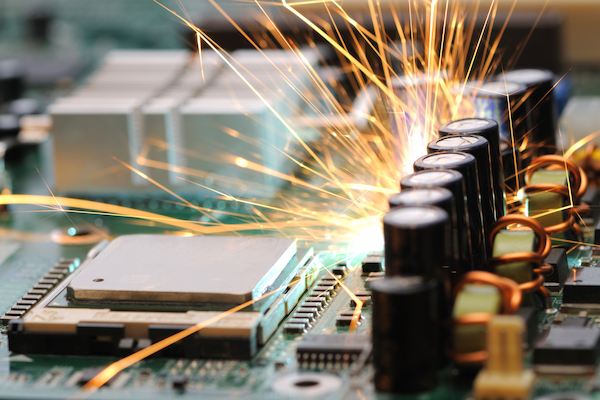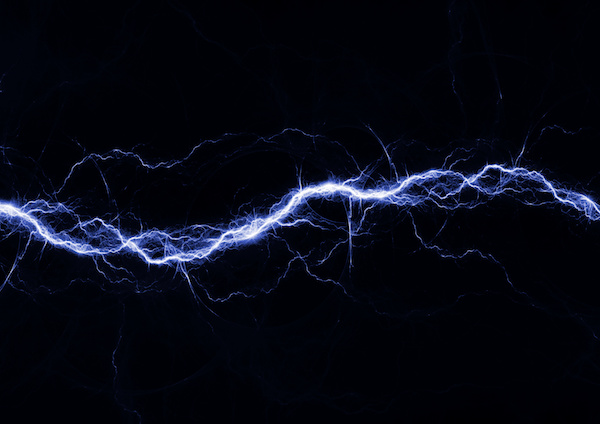Do you ever sit down on a metal chair and feel a shock run through you? It’s not a pleasant feeling.
Now imagine that shock going to your electronics. You can probably imagine how bad that could be.
This is called electrostatic discharge.
Now you may be wondering: what is electrostatic discharge? Keep reading to find out what it is, the damage it causes, and how you can prevent it.
Let’s dive in!
What Is Electrostatic Discharge?
Electrostatic discharge is what happens when the flow of electricity between two objects that are electrically charged is suddenly shorted by contact between those two objects. This happens because there has been a buildup of static electricity between the two objects.
Static electricity can build up between objects due to tribocharging or by electrostatic induction. Usually, when electrostatic discharge occurs, there is a visible spark of electricity between the two electrically charged objects that were brought together.

In fact, electrostatic discharge can produce amazing electrical spark shows. In the natural world, lightning that is accompanied by the sound of thunder is a large electrostatic discharge event. Other times, electrostatic discharge may produce no sparks or noise at all.
However, even when it is unnoticed, electrostatic discharge can still cause damage to electronic devices.
Dangers of Electrostatic Discharge
Industries that use electrical devices have to constantly be on guard against electrostatic discharge. It can have harmful effects on a variety of industries.
Electrostatic discharge can cause explosions in natural gas, vapors of auto fuel, and coal dust. Additionally, it can destroy integrated circuits. Because of the dangers to products and instruments from electrostatic discharge, the manufacturers of electronics have established areas in dangerous environments that are static-free. These are electrostatic-safe areas.
These areas are created by taking measures to prevent charging and remove static, such as:
Grounding Human Workers
Grounding workers prevents electrostatic discharge in sensitive environments. The use of wrist straps, footwear, and grounding mats allows workers to discharge any static electricity safely, reducing the risk of accidental sparks that could cause equipment damage or even explosions.
Supply Antistatic Devices
Antistatic devices are specifically designed to prevent the buildup and release of static electricity. These devices include antistatic wristbands, mats, and clothing that can safely dissipate electrical charges. Additionally, using ionizers in the workplace can neutralize static in the air, creating a safer environment for electronic components and reducing the risk of damage from electrostatic discharge.
Avoid Highly Charged Materials
Certain materials, such as plastics and synthetic fibers, are more likely to accumulate static electricity. In sensitive areas, it’s important to minimize the use of these materials or treat them with antistatic coatings to reduce their ability to hold a charge. Selecting materials with lower static generation properties can further reduce the risk of ESD.
Control Humidity in Environment
Maintaining optimal humidity levels is another effective strategy to prevent electrostatic discharge. Dry air is more conducive to the buildup of static electricity, while higher humidity levels can help dissipate charges more quickly. Installing humidifiers or monitoring air moisture levels can help maintain a balanced environment, preventing static accumulation and protecting sensitive equipment.
Following these steps will help decrease the chances of electrical discharge.
How Does Electrostatic Discharge Affect People?
The voltage of an electrostatic discharge can vary depending on what is involved. For instance, getting a shock from your carpet can range from 1,500V to 35,000V. Faulty electrical equipment can produce similar shocks in this range.
A person feels pain at 3,000V, meaning these shocks can result in someone being hurt temporarily. While not usually harmful, it can signal potential underlying issues.
What Is Tribocharging?
Tribocharging, which is a common cause of static electricity, can be accomplished through a variety of means. Walking on a rug is an example of tribocharging, as it brings two electrically charged materials (the human and the rug) together, then quickly separates them.
Rubbing a plastic comb on dry hair is another example of tribocharging that produces static electricity. Rubbing a balloon against a piece of wool, getting up from an upholstered car seat, and taking certain types of plastic packaging off of a product all generate static electricity through tribocharging. When one of the tribocharged items touches another charged item, a spark may be seen or felt, and electrostatic discharge occurs.
How Does Electrostatic Discharge Occur?
Electrostatic discharge can also occur via electrostatic induction. This happens when an electrically charged object is near an object with conductive properties that is not grounded.
The charged object creates a field of electrostatic energy that redistributes the electrical charges on the surface of the non-grounded object. When this happens, the un-grounded object now has areas where there is an excess of positive and negative charges on it.
Electrostatic discharge may occur when the un-grounded object touches something with conductivity. For example, the surface of Styrofoam cups causes electrostatic induction on nearby sensitive objects. Electrostatic discharge may occur if they are touched with anything made of metal.
Most spacecraft are prone to electrostatic discharge because of charged particles pinging against them. This causes increased charging on the surface, making them prone to electrostatic discharge.
Damage to Electronic Equipment

The most dangerous part of electrostatic discharge is the spark. It can cause minor pain to people and severe damage to electronic equipment. Fires and explosions may occur in areas with charged air and combustible gases and/or particles.
However, even without a spark, damage from electrostatic discharge can occur. Even tiny amounts of discharge can damage electronics. This can either break them completely or make them prone to degradation over time. This affects their long-term reliability and performance.
Types of ESD Events That Cause Electronics To Fail
Discharge to Electronic
This typically occurs when an electrostatic charge comes from a person to the device. For example, if they walked across the room and accumulated electrostatic charge and then began working on the device. Similarly, damage can occur if you use a charged conductive tool to work on an electronic during assembly.
Discharge From Electronic
Your electronic device can accumulate a static charge during manufacturing when rubbed against a surface or shipping in its packaging material. When things are mass-produced with automated assembly, it can lead to a higher chance of component failure.
Field-Induced Discharge
When an object becomes electrostatically charged, it creates an electrostatic field. When a device enters the field and is grounded, it accumulates charge. If it is then removed and grounded again, ESD may occur
Protecting Against Damage
Because electronic discharge damages so many electronic components, it is necessary to protect against it. Protect sensitive materials during every process including:
- Manufacturing
- Storage
- Shipping
- Assembly
- Consumption
An effective and important method of preventing electrostatic discharge is grounding. Ground regularly and routinely check that all components are properly positioned.
While electrostatic discharge is a natural phenomenon, it can damage electronic equipment, hurt humans, and even damage workplaces and cities. Minimize or prevent possible damage with the proper safety precautions in place. This is good for the safety of all.
Keep Your Devices Safe From Electrostatic Discharge With Hallmark Nameplate
If you have any questions about electrostatic discharge, contact Hallmark Nameplate. We maintain an ESD-Safe environment by not having an automated, fast-moving production line. This allows us to test and safely assemble our products for our customers.
Give us a call or visit our website and speak with seasoned professionals about our electronic assembly services.




